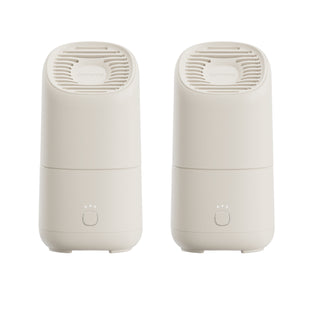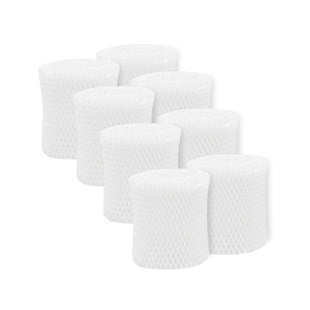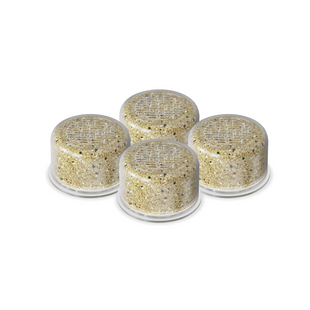There’s a meme that suggests humans are just houseplants with more complicated emotions because we, too, need plenty of oxygen, sunshine, and water to thrive. Although we are slightly more advanced than the average spider plant or pothos, there is some truth in the assessment of our basic needs.
The human/houseplant comparison is particularly obvious when it comes to water. Low humidity can cause discomfort like dry, itchy skin and nasal congestion, but it can also affect houseplants. Increasing the indoor moisture with a humidifier is one of the safest and most effective ways to help you both thrive.
Read on to understand why houseplants require proper humidification, how to identify that your plants aren’t getting enough, and discover tips on how to increase humidity for plants.
Why Humidity Matters for Your Houseplants
What is the simplest explanation for why your houseplants need proper humidification? Without enough water, they can wilt and die.
Most houseplants come from tropical regions, where the air is consistently warm and humid. Although most plants at your local nursery are reasonably hardy and can tolerate less-than-ideal conditions, at least temporarily, giving them the right amount of water is still vital to their survival.
It’s necessary to take a hands-on approach to humidification because plants lose water through a process called transpiration. Water escapes through tiny holes in the leaves. When the air is dry, the water escapes faster, which can cause the leaves to turn dry and brittle. If there’s enough moisture in the air, transpiration slows down, and the plant stays green and healthy.
Certain popular plants thrive in humid environments, and it’s essential to keep the humidity closer to 60% to ensure they take in plenty of water. These include:
- Snake plants
- Orchids
- Dracaena
- Ferns
- Lucky Bamboo
- Cast-Iron Plants
- Chinese Evergreen
Some plants, like succulents and cacti, prefer a dry environment, and excessive humidity can harm them. However, the on-trend air plant needs moisture to thrive and can struggle when the relative humidity (RH) drops below 40%.
Signs Your Home Is Too Dry for Houseplants

Humidity levels can often be low in the winter and spring, and steam heating systems only exacerbate the issue. During summer, your air conditioner continuously recycles dry air throughout your home.
Due to seasonal conditions, your home’s RH can get too low to support thriving houseplants. Even when you water them frequently, the dry air can pull the moisture out of the leaves, resulting in greenery that’s a little worse for wear.
Some of the most common signs of plant dehydration include:
- Dry, brittle foliage
- Discolored leaves, or leaves that turn brown around the edges
- Wilted stems or leaves
- Leaf drop
- Dry soil
It’s just as important to avoid overwatering plants as it is to keep them from getting too dry. Plants that are getting too much moisture share many of the telltale signs (leaf drop and wilting) as plants that are getting too little moisture. You will also spot soggy soil, and in some cases, mold or fungus on the soil, and brown leaf tips. Maintaining the ideal indoor humidity—around 50%—can help them thrive.
How To Increase Humidity for Plants
As a houseplant owner, your role in maintaining a steady indoor humidity level is crucial. Doing so protects your plants from stress and the effects of dry air. You can raise the indoor humidity to keep plants green and healthy.
Use a Humidifier
A cool mist humidifier is one of the best humidifiers for plants. Adding moisture via the evaporative technology of a Canopy 2.0 humidifier can help maintain consistent RH that slows transpiration and keeps your plants healthy. This method provides a reliable and effective solution to your plant care needs by monitoring moisture levels, ensuring RH remains stable.
Plants that live in rooms with plenty of humidity—like the bathroom or laundry room— typically don’t need support from a humidifier; but the moisture boost can help plants in dry rooms, like bedrooms or the living room.
The Mayo Clinic recommends keeping the humidity inside your home between 30% and 50%1, which is perfectly fine for most houseplants.
Maintaining proper humidification also benefits you and your family, as it can:
- Provide relief from congestion and respiratory symptoms in babies and adults
- Reduce the symptoms of the common cold
- Help alleviate allergy and asthma symptoms
- Improve the appearance of skin
- Soothe dry, red, and inflamed skin
- Help reduce the spread of bacteria and viruses that make you sick
If you’re using the humidifier to support houseplants, creating a more balanced environment helps prevent excess moisture, which can cause disease or allow fungal growth.
Over-humidifying can lead to issues like root rot, mold, and the spread of plant diseases. The best humidifier for plants is one that can detect proper humidity levels and turn itself off automatically. Canopy's Smart Persistent Airflow™ helps prevent mold, automatic mode allows the device to achieve the ideal humidity level.
The Pebble or Humidity Tray Method
Another option for increasing the humidity around your houseplants is to place them in a humidity or pebble tray. The process is easy: Add a layer of small pebbles to the bottom of a tray, then add water until it reaches halfway up the rocks. As the water evaporates, it helps increase moisture around the pot.
Plant Baths
A bath can clean your plants’ leaves (an important part of ensuring they get plenty of oxygen) and boost their moisture. Place all your plants in the tub, plug the drain, and run a lukewarm shower until a few inches of water is in the tub. Close the shower curtain and the bathroom door and allow the plants to rest in the humid environment for a few hours.
Canopy Filtered Showerheads remove high concentrations of hard minerals. We already know that hard water has a significant impact on hair and skin health—just think about what that can mean for a plant's health and soil pH.
The Canopy Handheld Filtered Showerhead reaches a plant’s crevices for a thorough cleaning.
Misting
Misting leaves adds moisture and slows down transpiration by reducing the amount of water that evaporates. However, avoid misting plants with hairy or fuzzy leaves2, as the droplets can get stuck on the leaves, damaging the plant and causing disease.
Arrange Plants for Optimal Humidity
Grouping your plants together can help keep them healthy and avoid dry air-related issues. If all the plants are close together and evaporating moisture, they can create a little pocket of humidity that benefits all of them.
Pair plants that have similar moisture requirements for maximum benefit. For instance, group plants that prefer high humidity to create a more suitable environment for them. Putting them on a pebble tray or close to a humidifier can also be beneficial.
Keep Your Houseplants Happy With Help From Canopy
Even if you don’t have a green thumb, the Canopy family of humidifiers can help make it seem like you do while keeping your home comfortable and your family healthy. The Canopy 2.0 humidifier features a new, more powerful filter that meets MERV1 filtration standards, a larger tank, a quieter fan, and more features you already love, like mold-inhibiting technology.
Canopy’s updated Bedside and Nursery humidifiers offer up to 500 square feet of hydration. A small humidifier for plants is a welcome addition to home offices, studio apartments, bedrooms, and other confined spaces. To hydrate plants in expansive areas, upgrade to the Large Room Humidifier and enjoy all the ease and convenience of the original with a capacity to hydrate spaces up to 1,000 square feet. Shop Canopy’s complete humidifier collection today and give your plants the moisture they need to thrive.
Sources:
- Humidifiers: Ease Skin, Breathing Symptoms. Mayo Clinic. Retrieved February 3, 2025, from https://www.mayoclinic.org/diseases-conditions/common-cold/in-depth/humidifiers/art-20048021
- (August 25, 2021). Misting Indoor Plants: The Whole Truth. Good Earth Plant Company Inc. Retrieved February 3, 2025, from https://www.goodearthplants.com/misting-indoor-plants-the-whole-truth































